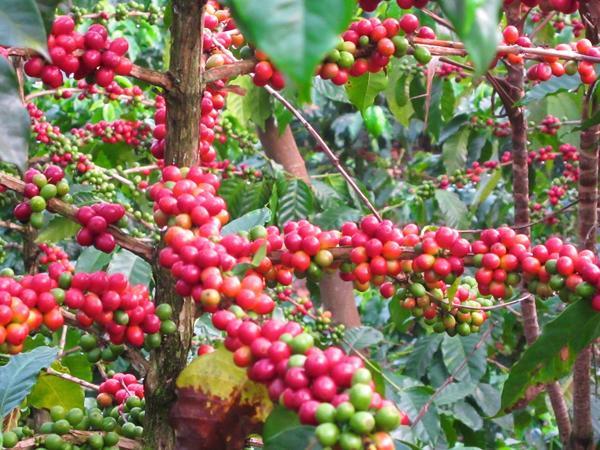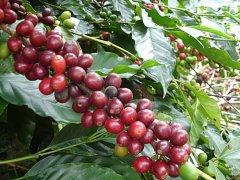Characteristics, uses and Origin of Ugandan Coffee & production Survey of Coffee products in Uganda over the years

For professional baristas, please follow the coffee workshop (Wechat official account cafe_style)
Uganda is a landlocked country in East Africa and is known as the "Pearl of Africa". Because of the dependent colonial economy, coffee accounts for most of the export income.
Coffee characteristics
Coffee beans are a commodity in global trading volume second only to crude oil. The rise and fall of prices are related to the political and economic stability of coffee-producing countries. For decades, coffee beans have been the most speculative commodity in the world. Generally speaking, it takes two to three years for coffee trees to bear fruit and five to six years for coffee to be harvested. Therefore, it is suitable for small farmers with limited funds to operate and avoid investment risks and losses.
There are about 40 varieties of coffee beans in the world, the common coffee ARABICA coffee grows in high altitude areas, the flavor is more rich, is a better coffee variety, ROBUSTA coffee grows in low altitude areas, easier to grow, caffeine content is also higher.
Coffee use
Coffee is used as a beverage. Most of the ground coffee used in Europe and the United States is ARABICA coffee, while ROBUSTA coffee is mainly made into instant coffee, which is a relatively cheap coffee.
Coffee producing area & output
Coffee is widely distributed in South America, Central America, the West Indies, Asia, Africa, Arabia, the South Pacific and Oceania. In terms of production, Brazil ranks first in the world, accounting for about 1/3 of the world, followed by Colombia, accounting for about 15 per cent of the world, followed by Africa (including C ô te d'Ivoire, Uganda, Kenya, etc.), Arabia, and distributed in Asian countries and islands.
ARABICA coffee is mainly produced in Brazil, Colombia, Mexico, Guatemala Mara, El Salvador, Honduras, Costa Rica, Nicaragua and other countries, mainly concentrated in Central and South America, Brazil is the most important producer of ARABICA coffee.
ROBUSTA coffee production is concentrated in Southeast Asia, Indonesia, Vietnam, Thailand, India and other countries.
Coffee supply & demand
Most of the coffee importing countries are developed countries, and the largest coffee importing countries in the world are the United States, Germany, Japan, South Korea, France and other countries, accounting for about half of the global coffee consumption. In addition, Brazil is also a major consumer, with annual per capita coffee consumption close to that of European countries.
The main exporters of coffee are Brazil, Colombia, Vietnam, Indonesia, Mexico, Uganda and other developing countries. As the trade barriers to coffee are lower than those of other agricultural products, and international organizations also encourage developing countries to grow coffee, poor countries are allowed to join the cultivation process.
Factors affecting the price of coffee
1. Climate, diseases and insect pests in the producing area
two。 Seasonal factors
3. International demand and supply
4. Government policies and International Coffee Organization measures
General situation of production and marketing of coffee products in Uganda over the years
Year
Output
Unit: thousand packs (60kg each)
Export volume
Unit: thousand packs (60kg each)
Year 2001
3265
2917
2002
2756
3150
2003
2745
2680
2004
2694
2520
2005
2175
2500
2006
2905
2000
2007
3490
2700
2008
3260
3210
2009
2870
3050
2010
3212
2670
2011
3075
3150
2012
3350
3000
2013
3500
3200
2014
2015
2016
Important Notice :
前街咖啡 FrontStreet Coffee has moved to new addredd:
FrontStreet Coffee Address: 315,Donghua East Road,GuangZhou
Tel:020 38364473
- Prev

What is the flavor of La Tisa Manor in Akanan Fruit producing area of Guatemalan Coffee?
For the exchange of professional baristas, please pay attention to the coffee workshop (Wechat official account cafe_style) Guatemalan coffee is mainly produced in eight major areas, one of which is the Akatnango Valley (AcatenangoValley) in Guatemala (AcatenangowbrValley). Coffee has been grown in Guatemala since the 1880s. Now at 6500 feet.
- Next

Coffee producer Uganda introduces the flavor characteristics of Ugandan coffee beans
For professional barista exchanges, please pay attention to the coffee workshop (Wechat official account cafe_style) absolute location: 12113.57 North 321715.45 East Uganda relative location: Uganda Republic, located in eastern Central Africa, reporting a land area of 241,040 km 2 at latitude 1. 30 S and 4. N. and in longitude 29. 30 and 35. Between E. It must be in the north by Sudan, in the east.
Related
- Detailed explanation of Jadeite planting Land in Panamanian Jadeite Manor introduction to the grading system of Jadeite competitive bidding, Red bid, Green bid and Rose Summer
- Story of Coffee planting in Brenka region of Costa Rica Stonehenge Manor anaerobic heavy honey treatment of flavor mouth
- What's on the barrel of Blue Mountain Coffee beans?
- Can American coffee also pull flowers? How to use hot American style to pull out a good-looking pattern?
- Can you make a cold extract with coffee beans? What is the right proportion for cold-extracted coffee formula?
- Indonesian PWN Gold Mandrine Coffee Origin Features Flavor How to Chong? Mandolin coffee is American.
- A brief introduction to the flavor characteristics of Brazilian yellow bourbon coffee beans
- What is the effect of different water quality on the flavor of cold-extracted coffee? What kind of water is best for brewing coffee?
- Why do you think of Rose Summer whenever you mention Panamanian coffee?
- Introduction to the characteristics of authentic blue mountain coffee bean producing areas? What is the CIB Coffee Authority in Jamaica?

